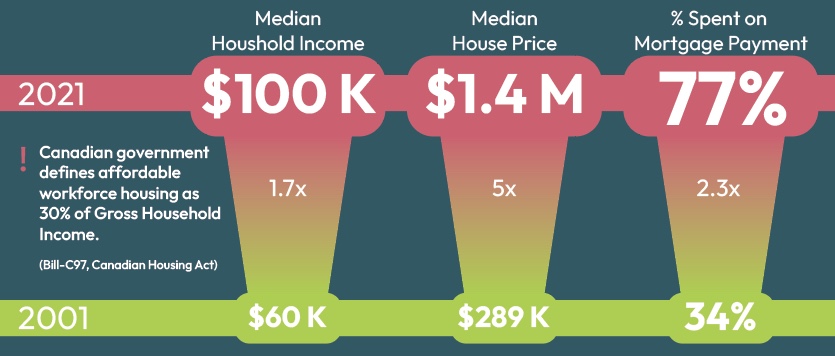Workforce Housing

Staffing challenges, due largely to unreasonable housing costs, is the number one challenge for businesses on the Saanich Peninsula.
The chamber has identified that the key issue for staffing challenges is the cost of living on the peninsula. Our staff cannot afford to rent or own homes or live in the communities where they work. That means that 70% of them are commuting an average of over 40km per day.
We desperately need adequate workforce housing that matches both the current demand and the federal governments stated affordability ratio of 30% of household income spent on housing costs.
Our workforce is spending up to 70% of their gross household income on their mortgage or rental payments alone. This is more than double what the Canadian government has stated as affordable. Even with a 20% down payment on the purchase price of a home on the peninsula median household ownership is out of reach for the majority of our staff.
Historical local municipal policies are the number one reason we are now in, and continue to be in crisis around housing affordability.
For over 30 years housing supply has not met the true demand for housing on the Saanich peninsula.
We are now in a cost of living crisis due to the historical inability to identify or meet the actual housing demand of our regions. Housing is the number one issue on the Saanich Peninsula that needs immediate action by our local municipal councils.
We are advocating for 3 things.

1 – Redefine housing demand calculations
Currently housing demand is based on historical residential population growth rates not on the actual current demand for housing units in each municipality. It is a calculation of how many people we have historically ‘let’ move onto the peninsula not how many people ‘need’ to live on the peninsula. It is a summation of the housing starts ‘allowed’ by municipalities and in no way represents the true need or demand for housing units.
Forced limited housing has not only caused unreasonable, unsustainable housing prices it has been massively impacting our local environments and needs to be considered and addressed.
- Over 70% of our workers are forced to commute mostly by car
- Average commute of 40km per day.
- Creating over 68,000 tonnes of CO2 emissions per year!
We must accurately define housing demand by using jobs in the region as a key indicator so that we can solve the housing needs crisis and improve the environmental impact of moving 70% of our workforce every day.
We believe that healthy communities are build when workers have the ability to live in the municipality that they work in. It allows them to take advantage of active transit opportunities, reduces pollution, keeps money in our local economy, and creates stronger human connections in the community. This is the ultimate solution to creating a healthy community while reducing environmental impacts.
We are advocating for a restructuring of the way housing demand is calculated. It must truly represent the actual demand for housing and be based on those who “want” to live in a municipality not just on those that can afford to live in a municipality. It needs to look at how many people that are employed in that municipality want to also live in that municipality.

2 – Urgent creation of 10,000 new housing units
Based mainly on calculations and predictions using the current amount of people that are working in each municipality and commuting to work we are suggesting that we are in a massive housing supply deficit. We urgently need an additional 10,000 new housing units on the Saanich peninsula to meet our historical unfilled housing demand debt. This is only to meet the current housing demand that will help make housing affordable. By providing more housing we will encourage workers to live in the municipalities that hey work in. Here is what we are suggesting for each municipality based on the amount of workers working there:
- Central Saanich needs 4,295 additional housing units:
- 774 – One Bedroom Units
- 1,826 – Two Bedroom Units
- 1,695 – Three Bedroom Units
- North Saanich needs 2,614 additional housing units:
- 436 – One Bedroom Units
- 1,207 – Two Bedroom Units
- 971 – Three Bedroom Units
- Sidney needs 2,591 addition housing units:
- 381 – One Bedroom Units
- 1,208 – Two Bedroom Units
- 1,002 – Three Bedroom Units
We are advocating for urgent zoning and bylaw changes that will allow for an addition of 20,000 new housing units on the Saanich Peninsula.

3 – Phase out R1 (Single Family) zoning on the Saanich Peninsula
Zoning reform is imperative to ensure a stable future. We know that this is a tough topic and that it could take years for our local governments to understand that you can protect property values without the use of exclusionary R1 (single family dwelling) zoning. We need to Advocate for the phasing out of R1 zoning hoping that it will, at the very least, be reduced in the short term and eliminated in the long term.
In 2019 the Canadian government passed Bill C-97 which, through use of the Canadian Housing Act, aligns Canada with international human rights. One of the human rights is the right to “adequate housing”. Two of the criteria for “adequate housing” are “affordability” and “location” (see below). The Canadian Government defined affordable as “30% of household income”
The Canadian Housing Act states that “housing is essential to the inherent dignity and well-being of the person and to building sustainable and inclusive communities as well as a strong national economy in which the people of Canada can prosper and thrive.”.
“Adequate Housing” includes these human rights.
- Protection against forced evictions and the arbitrary destruction and demolition of one’s home.
- The right to be free from arbitrary interference with one’s home, privacy and family.
- The right to choose one’s residence, to determine where to live and to freedom of movement.
“Adequate Housing” must provide
- Security of tenure: housing is not adequate if its occupants do not have a degree of tenure security which guarantees legal protection against forced evictions, harassment and other threats.
- Availability of services, materials, facilities and infrastructure: housing is not adequate if its occupants do not have safe drinking water, adequate sanitation, energy for cooking, heating, lighting, food storage or refuse disposal.
- Affordability: housing is not adequate if its cost threatens or compromises the occupants’ enjoyment of other human rights.
- Habitability: housing is not adequate if it does not guarantee physical safety or provide adequate space, as well as protection against the cold, damp, heat, rain, wind, other threats to health and structural hazards.
- Accessibility: housing is not adequate if the specific needs of disadvantaged and marginalized groups are not taken into account.
- Location: housing is not adequate if it is cut off from employment opportunities, health-care services, schools, childcare centres and other social facilities, or if located in polluted or dangerous areas.
- Cultural adequacy: housing is not adequate if it does not respect and take into account the expression of cultural identity.
Current R1 (Single Family) zoning policies stand in contradiction to the above rights to adequate housing.
- They currently treat housing as a commodity not a human right.
- They are exclusionary in nature designed only to serve those who already live in the region and to keep others out.
- They force money from middle class workforce renters into the hands of already wealthier citizens.
- They exclude most employees from living in, enjoying, and adding to the communities that they work in.
- They negatively impacts the environment.
- They use more land per person reducing land useable faming and green space.
